JATROPHA
Scientific Name: Jatropha spp
Common Names: Jatropha
Description: Jatropha species vary greatly in size, form, and appearance. Here are some general characteristics:
Size: Plants range from small succulents to large shrubs and even small trees, depending on the species.
Leaves: Leaves can be simple or lobed, with smooth or serrated edges. Leaf color can be green, gray-green, or even purple depending on the species.
Flowers: Flowers come in various shapes and colors, including red, orange, yellow, and white. Some species have showy flowers, while others have inconspicuous blooms.
Fruit: Produces capsules or drupes (fleshy fruits) containing seeds. Caution: The seeds of most Jatropha species are toxic and can be fatal if ingested.
Uses: Here’s a glimpse into some potential uses, depending on the specific species:
- Ornamental Plants: Some species with attractive flowers or foliage are cultivated as ornamentals in gardens.
- Biofuel: The seeds of Jatropha curcas have been explored as a potential source of biofuel, though its viability has faced challenges.
- Traditional Medicine: In some regions, certain Jatropha species have been used in traditional medicine practices.






